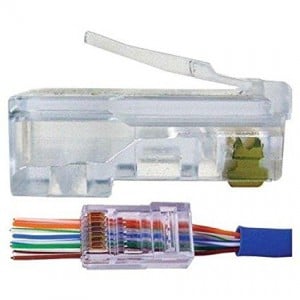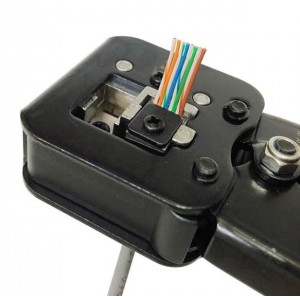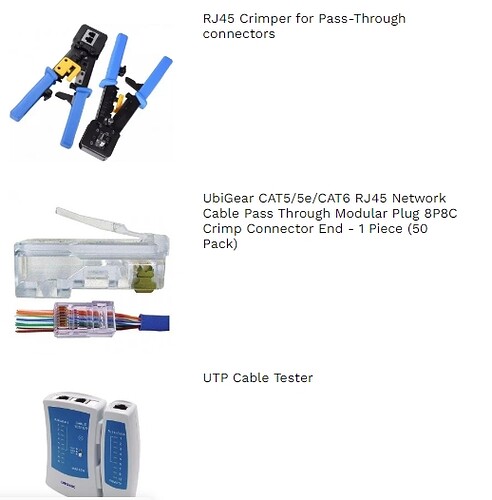hi folks, i have more or less laid cat5 from one central point in my home all over for cctv cameras [eish that was a schlepp doing conduits and pulling rope and wire, both electrical and data…] now obviously i want to further save by doing all crimping of jacks myself - any good tools out there? any i should avoid?
your jack of all? trades
gabriel
Have you crimped RJ45 plugs onto CAT cable before?
Not so easy but can be done.
Most of the crimpers are ok I reckon. The crimper doesn’t actually crimp the contact onto the wire - all it does is to press the contact through the insulation of the cable to make contact with the wire.
PS: Next time buy network cable with molded connectors.(They are available in different lengths)
I recommend an “EZ” crimper of any brand with pass-through jacks unless you like pain.


Then you don’t have to cut and line the wires up perfectly before pushing them into the jack. These are more expensive than standard jacks. All crimpers should be fine for the first 100 jacks, thereafter the quality starts mattering. Mine usually rust first.
I’ve used GeeWiz a couple of times, always fast shipping if something is in stock. Crimper looks like a good price, but the jacks are about double what I would expect… Shop around.
(To be fair, crimping network cable isn’t that hard, but by the time you’ve got the hang of it you’ll have wasted a whole bunch of jacks and probably have iffy cables that kinda work until the weather changes.)
thanks gents, odd lenghts made pre crimped cables impossible, but after consulting youtubes and digesting your advice - especially the pain prevention ![]() - i will go for the quality stuff, especially now that i save on external services.
- i will go for the quality stuff, especially now that i save on external services.
have a well connected week ![]()
regards
gabriel
Invest in a cable tester too. Cheap compared to the amount of debugging you’ll do to
- figure out which cable is which
- figure out which cable contains one dodgy connection.
^ This, makes a huge difference
I bought this. Includes tester … trust me, you need it.
It works.
I must be one very lucky SOB, that I’ve never had the bad luck of a bad crimp. Managed to get away without the tester for a really long time ![]()
I would never do this for a network. And I have done many - a good crimper and tester is all you need. It’s easy and you have no issues with dirty damaged connectors after a messy ceiling wire pull. PLUS you save huge amounts of cable!
It depends on how many network cables you’re installing. If you are needing to run a LAN cable from your ONT to your WiFi to have it better positioned in the house doing your own termination for one cable is a PITA.
‘Jacks’ :now that’s on old term… Does it apply to these RJ connectors?? (I’ve heard of ‘butterfly plugs’ but then my hearing isn’t very good)
great, so my essential list will be
- a pass through connector crimping tool, preferably the brand easy on arthritis hands
 ,
, - pass through connectors
- cable testing gadget
- wire cutting tool
- coffee
- pain tablets (optional)
edit:
in the post…
This part hits home, but it’s gout for me ![]() – You want a ratcheting one.
– You want a ratcheting one.
This is included in all crimpers I’ve seen, both cutting and stripping.
“RJ” means “Registered Jack” ![]() But RJ45 is technically the wrong name for an 8P8C crimp connector, but if you’re the type of person to be upset about this you’re going to have a bad time!
But RJ45 is technically the wrong name for an 8P8C crimp connector, but if you’re the type of person to be upset about this you’re going to have a bad time!
Like “RS” means “recommended standard”, and RFC means “Request for Comments”. It probably made perfect sense when the acronym was coined ![]()
Pity I missed out on this debacle. I reckon you would only know this if you’re a networking guru…
However I stand my ground with ‘jack plug’. Google it and see what comes up…
The way I have it, the socket (female) is colloquially called a “jack” and the connector (male) is called a “plug”.
Why the female is a jack would forever be a mystery to me.
registered Jill 45
![]()
Careful, this is another technical area someone will want to reform at some point…
(I mean, I get it and all, but the way people just ignore context irks me. This is OT, I know ![]() People renaming “master” to “main” to avoid connotations with historical wrongdoing… completely missing the point that a master key or a master copy has the same non-existent problem, and is contextually much more similar in meaning).
People renaming “master” to “main” to avoid connotations with historical wrongdoing… completely missing the point that a master key or a master copy has the same non-existent problem, and is contextually much more similar in meaning).
The DIN standards are a pleasure by comparison since they define the gizmo and provide a name for it.
Why there isn’t a DIN standard in this arena I know not ![]()
now just the other day the craziest popped up here on the west coast… in a document a soldier, in this case female - but not that it matters at all -was not addressed as ms or mrs or colonel or whatever but, wait for the afrikaans, a ‘krygspraktisyn’ - so this opens the field [battlefield?] to the most insane and absurd nomenclature imaginable…
edit
which makes a petroljoggie a propulsiemiddelpraktisyn? ![]()
I trust that this thread is solved but the discussion progressed onto standards which is close to my heart.
Full credit must be given to revolutionary France for introducing the SI system. The peasants who were paid for their crop by the aristocracy had their crop measured by them. This led to much abuse about how anything was measured. So all the more reason to send the guilty to the guillotine but something more needed to be done and the (metric) SI system was established.
To their credit they sent representatives all over the world (with samples) to encourage the adoption of these standards. The one country that missed out was the US. The story goes that the sailboat on its voyage to the US was blown off course and landed up in a hostile island in the West Indies. So alas the US didn’t ‘get on the bus’ and has not managed it ever since. For the biggest economy in the world this is incredible. What were they thinking? That the Imperial system would prevail? (Perhaps the ANC with their strange agenda can explain this…)
I haven’t seen any figures but the cost to the US economy must have been huge.
So we can’t really expect any meaningful standards to emenate from the US so hence the confusion…
